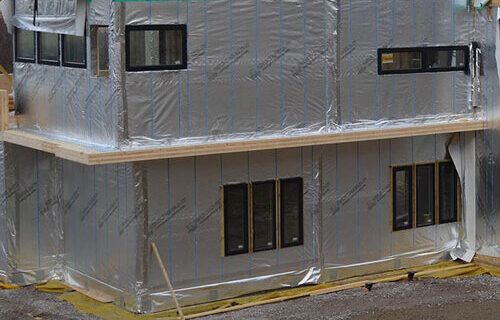Since 2004, we at the A. Proctor Group have been continually evolving our two reflective construction membranes, the vapour permeable Reflectashield and its vapour control layer counterpart Reflectatherm, and today in 2014 we have developed these products to give the highest reflective insulation performance available in each class at 0.81m2K/W and 0.79m2K/w respectively. So after 10 years in this marketplace, it seemed appropriate to “reflect” on how we got here.
First of all, it may be helpful to consider how reflective insulation membranes actually work. All such membranes work by restricting the transfer of infra-red radiation (commonly known as “heat”). In fact it can be argued the term “reflective” is actually something of a misnomer in this case, since the physical property governing the insulative performance relates not to reflection, but rather to emission and absorption of IR radiation.
The “emissivity” of a material is a measure of how easily the surface of a material can either absorb or emit radiation, in much the same way as tinted glass used in limousines makes it harder to see both in and out. When a reflective surface is used on a vapour control layer (on the warm side of the insulation, generally facing inwards) this surface limits the ability of the wall to absorb the heat from inside the building, leading to a reduced rate of heat flow, or u-value.
On the cold side of the insulation, reflective breather membranes make the outer surface less able to emit the heat back out again, which has the same effect. By definition heat that is not absorbed or emitted, is therefore reflected back into the building envelope. So (somewhat counter intuitively) the reflective surface does not need to point towards the heat source for reflective insulation to work. The only requirement is that the reflective surface faces an airspace, in order to maximise the proportion of heat transfer by radiation (as opposed to conduction).
So how do we determine the effects these materials have on the overall u-value of the wall construction? There are several methods which can be used, however following extensive consultation with our partners and customers in the timber frame industry, we settled on the guarded hot box method as defined in BS EN ISO 8990, a long established and widely used method of determining insulation performance.
This method uses a precisely calibrated heated box laden with 25 separate heat flow metres, allowing the changes in temperature across a test sample to be measured to an accuracy of 0.1°C. The samples used in this testing are in effect scale models of real timber frame wall panels, giving the closest approximation possible (under lab conditions) to the real world performance of the two membranes. The testing and measurements were conducted by the National Physical Laboratory based at Teddington in southwest London, a widely recognised centre of excellence in measurement practice, and the largest applied physics organisation in the UK.
In addition to its market leading and TRADA certified thermal resistance of 0.81, the Reflectashield-TF breather membrane can uniquely be offered with custom printing of customer logos to any design specified. Traditionally reflective membranes are supplied unprinted due to the ink reducing the thermal performance, however using advanced image processing techniques adapted from medical cell analysis we are able to account for these effects and adapt the required print images to minimise the reduction in performance. This gives our customers the same bespoke printing options already offered with our non-reflective Frameshield and Roofshield breathable membranes. Both membranes are also available in a range of roll sizes to meet the differing requirements of on and off site installation processes.
